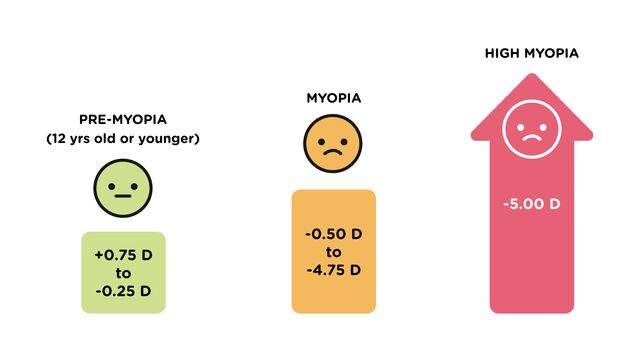Understanding Myopia
Why should parents be concerned?

Myopia: More than just nearsightedness
Myopia, also commonly referred to as shortsightedness, is when the eye grows too long from front to back, making it harder to focus on things that are far away.1 For example, a person with myopia may be able to read a book just fine, but may struggle to read a street sign. While blurry distance vision is the most well-known symptom of myopia, it’s important to note that myopia also increases the chances of eye complications later in life. That’s because the lengthening of the eye means more strain on delicate structures like the retina (the part of the eye that turns light into what you see). Myopia is also very common, and only becoming more common by the day.
Myopia in Children is a Growing Problem

Previously, myopia was thought of as simply shortsightedness or blurry distance vision.1 We now know it’s so much more. Myopia is a chronic, progressive disease that is affecting children at a rapid pace.1-3 The number of people with myopia has nearly doubled over the past 20 years.4 It’s estimated that up to 25-30% of children in Australia and New Zealand have myopia.5
Every Change in Eyesight Matters

While high levels of myopia tend to increase the risk of sight-threatening complications later in adulthood, there is no safe level of myopia. Even lower levels of myopia can increase the risk of complications.1 Every dioptre increase in myopia (e.g. a change in prescription from -2D to -3D) raises the risk of myopic macular degeneration - a sight-threatening eye disease - by 67 percent.6
What Can I Do About My Child’s Myopia?
Once a child develops myopia, it s very likely to worsen as they grow, resulting in the need for higher and higher prescriptions for glasses or contact lenses.7

- It is recommended that all children have a comprehensive eye examination with an Eye Care Professional before starting school and continue with regular eye examinations thereafter.8
- A comprehensive eye exam which is much more extensive than an annual vision screening at school can detect the early signs of myopia, as well as more than 270 systemic and chronic diseases.9
Making Adjustments to Your Child’s Routine
Simple lifestyle changes may help reduce the likelihood of developing myopia:
More time outdoors
Research shows that spending at least two hours per day outdoors can help reduce myopia onset or slow its progression.10
Less near work
Reducing the amount of time spent on near work (e.g. reading, tablets) outside of school can help reduce myopia onset.11
The 20-20-20 rule
Every 20 minutes, look 20 feet away for 20 seconds when doing nearwork activities like reading, screentime, or homework.12
Is My Child at Risk of Myopia?
1. Flitcroft DI. The complex interactions of retinal, optical and environmental factors in myopia aetiology. Progress in Retinal and Eye Research. 2012 31(6):622-660.
2. Donovan L, Sankaridurg P, Ho A, et al. Myopia progression rates in urban children wearing single-vision spectacles. Optom Vis Sci. 2012;89(1):27-32.
3. Pärssinen O, Kauppinen M. Risk factors for high myopia: a 22-year follow-up study from childhood to adulthood. Acta Ophthalmologica. 2019;97(5):510-518.
4. Holden BA, Fricke TR, Wilson DA, et al. Global Prevalence of Myopia and High Myopia and Temporal Trends from 2000 through 2050. Ophthalmology 2016;123:1036-42.
5. Myopia: Aotearoa’s inaugural report card, NZ Optics. Accessed: 05/05/2024. Link: www.nzoptics.co.nz/live-articles/myopia-aotearoa-s-inaugural-report-card.
6. Bullimore MA, Brennan NA. Myopia-control: Why Each Diopter Matters. Optom Vis Sci.
7. Morgan IG, French AN, Ashby RS, Guo X, Ding X, He M, Rose KA. The epidemics of myopia: Aetiology and prevention. Prog Retin Eye Res. 2018 Jan;62:134-149.
8. The Australia and New Zealand Child Myopia Report 2022/23 – Reducing the Risk to Vision. An adjunct report by the Australia and New Zealand Child Myopia Working Group.
9. American Optometric Association. See the Full Picture of Your Health with an Annual Comprehensive Eye Exam. AOA, 2025. https://www.aoa.org/healthy-eyes/caring-for-your-eyes/full-picture-of-eye-health.
10. Wu PC, Chen CT, Lin KK, et al. Myopia Prevention and Outdoor Light Intensity in a School-Based Cluster Randomized Trial. Ophthalmol. 2018;125:1239-50.
11. Huang PC, Hsiao YC, Tsai CY, Tsai DC, Chen CW, Hsu CC, Huang SC, Lin MH, Liou YM. Protective behaviours of near work and time outdoors in myopia prevalence and progression in myopic children: a 2-year prospective population study. Br J Ophthalmol. 2020 Jul;104(7):956-961.
12. Optometry Australia. Looking Each Other in the Eye Can Save Your Relationship and Your Eyes. 2023, https://www.optometry.org.au/wp-content/uploads/Media_releases/looking_each_other_in_the_eye_can_save_your_relationship_and_your_eyes_revised.pdf.
2025PP12210